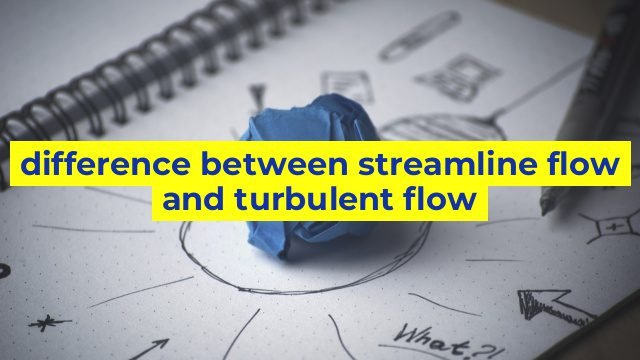Difference between Streamline Flow and Turbulent Flow
What is Streamline Flow?
Streamline flow is a type of fluid flow where the fluid particles move in a smooth and continuous manner along a fixed path. This type of flow is also known as laminar flow. In streamline flow, the fluid moves in layers, with each layer sliding over the adjacent layer without any disturbance or mixing. The motion of fluid is regular, and the velocity of fluid particles remains constant at any point in the flow.
Streamline flow is usually observed in low-pressure systems, where the flow rate or velocity of the fluid is comparatively low. This type of flow is also common in highly viscous fluids like oil, syrup, or honey.
What is Turbulent Flow?
Turbulent flow is a type of fluid flow where the fluid particles move in an irregular and chaotic manner. In turbulent flow, the fluid particles move in a random and erratic manner, changing their direction and velocity frequently. The motion of fluid is highly irregular and unpredictable, creating eddies, whirlpools, and vortices throughout the flow.
Turbulent flow is usually observed in high-pressure systems, where the flow rate or velocity of the fluid is high. This type of flow is also common in low-viscosity fluids like air or water.
Differences between Streamline Flow and Turbulent Flow
1. Nature of flow:
Streamline flow is a smooth and continuous flow where the fluid particles move in a regular and predictable manner, while turbulent flow is an irregular and chaotic flow where the fluid particles move in a random and unpredictable manner.
2. Velocity of fluid particles:
In streamline flow, the velocity of fluid particles remains constant at any point in the flow, while in a turbulent flow, the velocity of fluid particles changes frequently.
3. Formation of eddies and vortices:
In streamline flow, no eddies or vortices are formed and the fluid particles move in a straight line, while in turbulent flow, eddies, vortices, and whirlpools are formed throughout the flow.
4. Energy dissipation:
Streamline flow dissipates less energy compared to turbulent flow, making it more efficient for many engineering applications.
In conclusion, streamline flow and turbulent flow are two different types of fluid flow that have their own unique characteristics and properties. Understanding the differences between these flow types is essential for engineers, scientists, and researchers who are working in the field of fluid dynamics.
Table difference between streamline flow and turbulent flow
| Property | Streamline Flow | Turbulent Flow |
|---|---|---|
| Definition | Fluid flow in which the velocity at every point in the fluid remains constant over time | Fluid flow characterized by irregular fluctuations in velocity and pressure |
| Fluid behavior | Laminar flow with smooth fluid motion | Chaotic flow with eddies, swirls, and vortices |
| Reynolds Number | Low Reynolds number (Re < 2000) | High Reynolds number (Re > 4000) |
| Viscosity | Higher viscosity fluids produce streamline flow | Lower viscosity fluids can result in turbulent flow |
| Energy Dissipation | Low energy dissipation due to less friction | High energy dissipation due to more friction |
| Flow Velocity | Uniform flow velocity | Fluctuating flow velocity |

